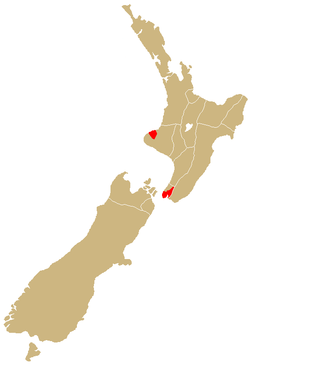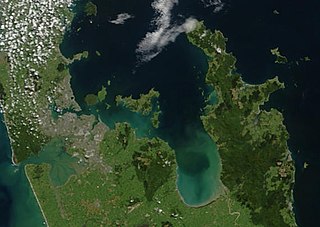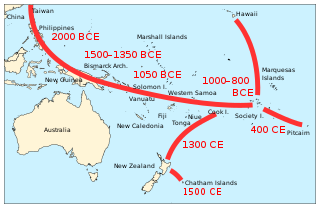
Kupe was a legendary Polynesian explorer who, according to Māori oral history, was the first person to discover New Zealand. It is likely that Kupe existed historically, but this is difficult to confirm. He is generally held to have been born to a father from Rarotonga and a mother from Raiatea, and probably spoke a Māori proto-language similar to Cook Islands Māori or Tahitian. His voyage to New Zealand ensured that the land was known to the Polynesians, and he would therefore be responsible for the genesis of the Māori people.
Arawa was one of the great ocean-going, voyaging canoes in Māori traditions that was used in the migrations that settled New Zealand. The Te Arawa confederation of Māori iwi and hapū based in the Rotorua and Bay of Plenty areas trace their ancestry from the people of this canoe.

Māori oral histories recount how their ancestors set out from their homeland in waka hourua, large twin-hulled ocean-going canoes (waka). Some of these traditions name a homeland called Hawaiki.

In Māori tradition, Aotea is one of the canoes in which Māori migrated to New Zealand; it is particularly associated with the tribes of Taranaki and Whanganui, including Ngāti Ruanui, Ngāruahine, Ngā Rauru and other tribal groups.
Tākitimu was a waka (canoe) with whakapapa throughout the Pacific particularly with Samoa, the Cook Islands, and New Zealand in ancient times. In several Māori traditions, the Tākitimu was one of the great Māori migration ships that brought Polynesian migrants to New Zealand from Hawaiki. The canoe was said to have been captained by Tamatea.
Mātaatua was one of the great voyaging canoes by which Polynesians migrated to New Zealand, according to Māori tradition. Māori traditions say that the Mātaatua was initially sent from Hawaiki to bring supplies of kūmara to Māori settlements in New Zealand. The Mātaatua was captained by Toroa, accompanied by his brother, Puhi; his sister, Muriwai; his son, Ruaihona; and daughter, Wairaka.
Kurahaupō was one of the great ocean-going, voyaging canoes that was used in the migrations that settled New Zealand in Māori tradition.

Māori mythology and Māori traditions are two major categories into which the remote oral history of New Zealand's Māori may be divided. Māori myths concern tales of supernatural events relating to the origins of what was the observable world for the pre-European Māori, often involving gods and demigods. Māori tradition concerns more folkloric legends often involving historical or semi-historical forebears. Both categories merge in whakapapa to explain the overall origin of the Māori and their connections to the world which they lived in.

Te Āti Awa or Te Ātiawa is a Māori iwi with traditional bases in the Taranaki and Wellington regions of New Zealand. Approximately 17,000 people registered their affiliation to Te Āti Awa in 2001, with about 10,000 in Taranaki, 2,000 in Wellington and 5,000 of unspecified regional location.

Te Aitanga-a-Hauiti is a Māori iwi (tribe) on the East Coast of New Zealand's North Island. Its rohe covers the area from Tawhiti-a-Paoa Tokomaru Bay to Te Toka-a-Taiau Gisborne on the East Coast of the North Island of New Zealand.
In Māori tradition, Māhuhu-ki-te-rangi was one of the great ocean-going, voyaging canoes that was used in the migrations that settled New Zealand.

Ngāti Pāoa is a Māori iwi (tribe) that has extensive links to the Hauraki and Waikato tribes of New Zealand. Its traditional lands stretch from the western side of the Hauraki Plains to Auckland. They also settled on Hauraki Gulf islands such as Waiheke.

Ngāti Tamaterā is a Māori iwi (tribe) of the Hauraki region of New Zealand, descended from Tamaterā, the second son of Marutūāhu. It is a major tribe within the Marutūāhu confederation and its leaders have been prominent in Hauraki history and Marutūāhu tribal affairs. It is one of five tribes of the Marutūāhu confederation, the others being Ngāti Maru, Ngāti Paoa, Ngāti Rongoū and Ngāti Whanaunga. The Marutūāhu tribes are all descended from Marutūāhu, a son of Hotunui, who is said to have arrived in New Zealand on the Tainui canoe. The Marutūāhu tribes are therefore part of the Tainui group of tribes. The Marutūāhu confederation is also part of the Hauraki collective of tribes.
In Māori tradition, Tinana was one of the great ocean-going, voyaging canoes that was used in the migrations that settled New Zealand.
In Māori tradition, Tōtara-i-kāria was one of the great ocean-going, voyaging canoes that was used in the migrations that settled New Zealand. The waka is linked to the Bay of Plenty region. Legend has it that this was the waka taken by the priest Ngātoroirangi back to Hawaiki; upon arrival, he fought a battle at Ihumotomotokia and Whatatiri, against the chief Manaia. He defeated Manaia, and then returned to his pā (fortification) in New Zealand, on Mōtītī Island in the Bay of Plenty. However, the survivors of Manaia's tribe soon arrived in a fleet of canoes to seek revenge. Ngātoroirangi chanted incantations whipping up a storm that destroyed them.
Uruaokapuarangi was one of the great ocean-going, voyaging canoes that was used in the migrations that settled the South Island according to Māori tradition.

Since the early 1900s it has been accepted by archaeologists and anthropologists that Polynesians were the first ethnic group to settle in New Zealand. Before that time and until the 1920s, however, a small group of prominent anthropologists proposed that the Moriori people of the Chatham Islands represented a pre-Māori group of people from Melanesia, who once lived across all of New Zealand and were replaced by the Māori. While this claim was soon disproven by academics, it was widely incorporated into school textbooks during the 20th century, most notably in the School Journal. This theory has been followed by modern claims of a pre-Māori settlement of New Zealand by various ethnic groups. Today, such theories are considered to be pseudohistorical and negationist by scholars and historians.

Marutūāhu is a confederation of Māori iwi (tribes) in the Hauraki region of New Zealand. The confederation comprises the tribes of Ngāti Maru, Ngāti Pāoa, Ngāti Tamaterā, Ngāti Whanaunga and Ngāti Rongoū.
The Gisborne District or Gisborne Region has a deep and complex history that dates back to the early 1300s. The region, on the East Coast of New Zealand's North Island, has many culturally and historically significant sites that relate to early Māori exploration in the 14th century and important colonial events, such as Captain Cook's first landfall in New Zealand.
Rākaihautū was the captain of the Uruaokapuarangi canoe and a Polynesian ancestor of various iwi, most famously of Waitaha and other southern groups, though he is also known in the traditions of Taitokerau and in those of Rarotonga.








